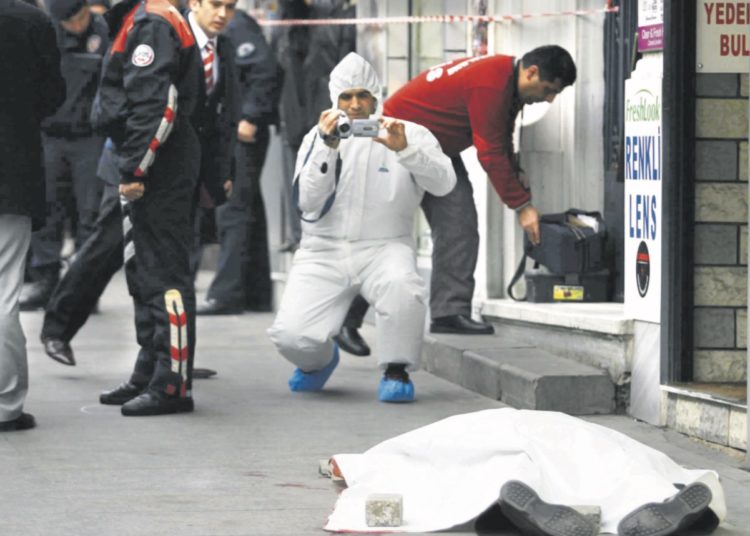Abdullah Bozkurt
Turkey’s National Intelligence Organization (MİT), implicated in the murder of an Armenian-Turkish journalist, feigned ignorance when asked whether the agency had collected information on the Armenian minority in Turkey before the murder took place.
According to a secret intelligence document obtained by Nordic Monitor, the agency sent a communication to a court in Istanbul denying that it had conducted surveillance on Armenians in Turkey or spied on the low-circulation Turkish-Armenian community newspaper Agos. The newspaper’s editor-in-chief, Hrant Dink, a Turkish journalist of Armenian origin, was shot dead by an ultranationalist teenager in broad daylight on January 19, 2007 after he was threatened by MİT agents in the governor’s office.
The document, classified as secret and dated July 19, 2010 under correspondence No. 0.2.001.01.000.390.673-1030/285, showed the agency as having denied collecting any information on Armenians and Agos and receiving information about the murder. MİT’s deputy legal counsellor, S. Asuman Bozoklu, who signed the document on behalf of the head of the spy agency, claimed the meeting held with the slain journalist and two agents at the Istanbul Governor’s Office building was simply to convey information to the journalist rather than to threaten him.
The reality is far from what MİT tried to portray as the facts, however. The incident that revealed MİT’s campaign of intimidation targeting Dink took place on February 24, 2006 in the İstanbul Governor’s Office headquarters following a phone call from the Office of the Chief of General Staff to then-MİT Undersecretary Şenkal Atasagun. The top brass, controlled by neo-nationalist generals at the time, asked MİT to give Dink a scare because of an article he published in the Agos newspaper about Sabiha Gökçen — the adopted daughter of the founder of modern Turkey, Mustafa Kemal Atatürk, and Turkey’s first female pilot — that suggested Gökçen could be one of the thousands of Armenians who were orphaned in 1915 when the community experienced a mass deportation that led to many deaths.

Following instructions from the military top brass, MİT Undersecretary Atasagun tasked Hüseyin Kubilay Günay, the MİT İstanbul regional director, with delivering the message to Dink. Then-Governor Muammer Güler and Günay decided that the meeting should be held at the governor’s office building on February 24, 2004. According to the testimony of former İstanbul Deputy Governor Ergun Güngör, the journalist was threatened by two MİT officials in his office on an order from then-İstanbul Governor Güler.
The meeting was attended by Güngör, Dink, Özel Yılmaz, deputy regional director of MİT in İstanbul who was also leading the agency’s counterterrorism department, and Handan Selçuk, another MİT agent. Dink was invited to the meeting to be warned of “possible danger if he continued to make controversial statements.” “During the meeting, we talked about the fact that [Dink’s] report about Gökçen might create [unease] among the public,” Güngör admitted in a statement to İstanbul Public Prosecutor Gökalp Kürkçü. The İstanbul Police Department was not informed about the meeting.
The meeting at the governor’s office building came a week after Dink had suggested that Gökçen was in fact an Armenian orphan. During the conversation the deputy governor and the two MİT officials threatened Dink, saying, “We know who you are, but society may not,” and “We are concerned that society might not be able to understand things like this.” Dink later acknowledged in his weekly column that he felt threatened by what the two MİT officials called a “warning” in the office of the then-deputy governor.
The agency’s secret document also falsely claimed that no surveillance of the Armenian community was carried out by MİT. In fact, it was revealed in 2004 that Turkey’s National Security Council (MGK) instructed security agencies to monitor minority Christian groups and spy on their activities including their missionary work, which was deemed a threat to Turkey’s national security. Dink had been viciously targeted by clandestine elements in the army, judiciary and other branches of the government.
The government of President Recep Tayyip Erdoğan prevented any investigation of MİT agents in a case that was launched into senior officials in the police department and military for dereliction of duty in protecting Dink. Erdoğan even asserted that the murder was personal rather than a complex plot, effectively shutting down the investigation into the real masterminds behind the triggerman.
Instead, journalists Bayram Kaya, a security specialist and reporter with the now-defunct daily Zaman, and Ercan Gün, a veteran journalist who was working for Fox TV’s Turkish channel, were both jailed on dubious charges after they exposed the complicity of the intelligence service elements in the murder. Police chiefs Ramazan Akyürek, whose office in Trabzon warned about Yasin Hayal’s plans to assassinate Dink, on February 17, 2006, and Police Chief Ali Fuat Yilmazer, who helped expose the masterminds behind the murder, were made scapegoats and imprisoned by the Erdoğan government. Hayal was the instigator in the assassination plot.












